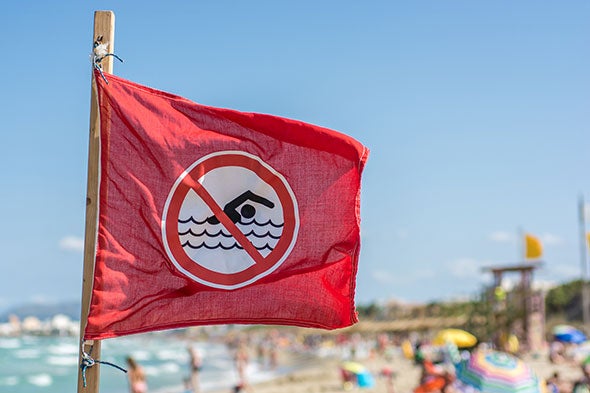Water Safety Rip Currents — Enjoy Summer Fun, but Stay Safe
June 16, 2024
By: WakeMed Health & Hospitals
Categories: Emergency, Raleigh Campus
Tags: drowning, rip currents, rip tides
It’s officially summer and the staggering statistics are out: In 2020, seven people drowned in the North Carolina surf. The cause of three of them? Rip currents.
Wilmington Surf City Fire Chief Allen Wilson reported that by end of May 2020, they “had more rescue calls than all of [the prior] year.” The main reason for so many rescues were rip currents.
Safe Kids Chairman, Mike Causey, Offers Water Safety Tips
“The safety of our residents and children is one of my top priorities,” said Safe Kids chairman and Insurance Commissioner Mike Causey. “I urge everyone to be on alert for hazardous swimming conditions while they are enjoying the water this summer. Please heed the safety tips provided.”
Drowning is the number one cause of unintentional deaths worldwide. In the U.S., it ranks number five. Here’s how to avoid it:
#1 – Watch For Rip Currents
- If you see a current of choppy, off-colored water extending from the shore, steer clear.
- If you do get pulled out, stay calm, let the current carry you for a while and keep breathing. Don’t try to swim against the current!
Dr. Graham Snyder, WakeMed Medical Director for the Medical Simulation Center and emergency physician says, “The direction and speed of rip currents is highly variable, so swimming parallel can sometimes quickly get you out of the current or the current may push against you. However, rip currents never continue out to sea more than a couple hundred feet and, in many cases, will circulate you back into water you can stand up in. As long as you don’t panic and exhaust yourself, you will eventually make it safely back to shore.”
- Once out of the current, swim diagonally towards the shore. If you can’t make it to the shore, wave your arms and make noise, so someone can see or hear you and get help.
How do rip currents form?
Rip currents are a strong channel of water extending from the shore out into the water. When waves break more strongly than others onto the shore, they can cause a circulation in the water that produces a rip current. Rip currents tend to form near a shallow point in the water, such as a sandbar, or close to jetties and piers and can happen at any beach with breaking waves. Their force is strong enough to pull the strongest swimmer out to sea.

#2 – Heed the Warning Flags
- Red flags indicate strong surf and currents.
- Yellow flags indicate moderate surf and currents — the water is likely to be rough but not exceedingly dangerous. Exercise caution and stay near the lifeguards.
- Green flags indicate the ocean is calm or clear.
- Blue or Purple flags often indicate that potentially dangerous marine life (think sharks or jellyfish) are in the area or have been spotted nearby.
#3 – Know How to Swim
- Be prepared to deal with strong surf before running in. Ocean swimming is different from swimming in a pool or lake.
- Make sure everyone has a well-fitting lifejacket if you’re at the beach with a child or adult who can’t swim.
- Be prepared to swim in water over your head. When heading into the water, be aware that the ocean floor can drop off unexpectedly. The ocean floor is not flat and beaches can change drastically from year to year.
- Obey the buddy system while swimming. Keep a friend nearby in case either of you ends up needing help.
- Pick a swimming spot close to a lifeguard. Lifeguards are there for a reason — they know and can see things about the beach that most beach-goers don’t.
Be aware of the waves. Waves are powerful. A recent study out of Delaware found that injuries resulting from strong waves can range from simple sprains, broken collarbones, and dislocated shoulders to more serious injuries including blunt organ trauma and spinal injuries, which can lead to paralysis.

#4 – Watch for Sun Sickness or Heatstroke
A few hours in the sun can cause serious symptoms and may even lead to severe sickness. Heat exhaustion, heat stroke and sun poisoning can result from dehydration and extended exposure to high temperatures. Make sure to stay hydrated by drinking plenty of water. Avoid dehydrating liquids such as coffee of alcohol.
Symptoms of heat exhaustion, heat stroke, and sun poisoning include: confusion and dizziness, fatigue, headache, muscle cramps or weakness, nausea, excessive sweating or lack of sweating, pale skin, swelling of the hands or face, rapid heartbeat, and confusion. Sun poisoning can also be indicated by skin redness and blistering, pain and tingling, or fever and chills.
If these symptoms are displayed: Get out of the sun and heat, remove any unnecessary clothing, drink plenty of water, and take a cool bath or shower. Seek medical attention if symptoms are on the severe side — swelling, confusion, painful and blistering sunburns.
About Safe Kids Wake County
Every year in North Carolina, more than 200 children die from accidental injuries and another 45,000 visit a doctor’s office for treatment. Safe Kids Wake County aims to reduce the number of preventable injuries and death in Wake County, NC children ages 19 and under.
Safe Kids Wake County is comprised of organizations, businesses and individuals throughout Wake County who share an interest in child safety. Interested in getting involved? Regular meetings are held on the fourth Thursday of the month from noon to 1 pm at the Andrews Conference Center on the WakeMed Raleigh Campus. Call 919-350-8364 for additional information or visit our webpage here.